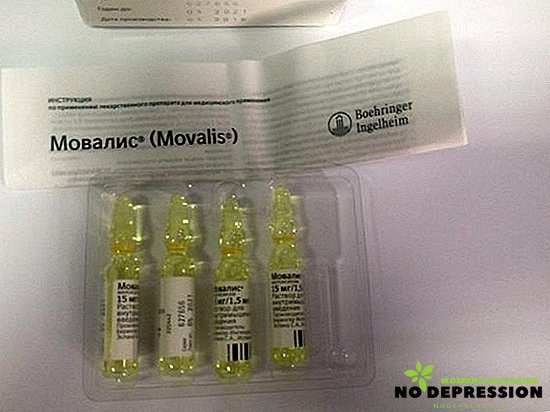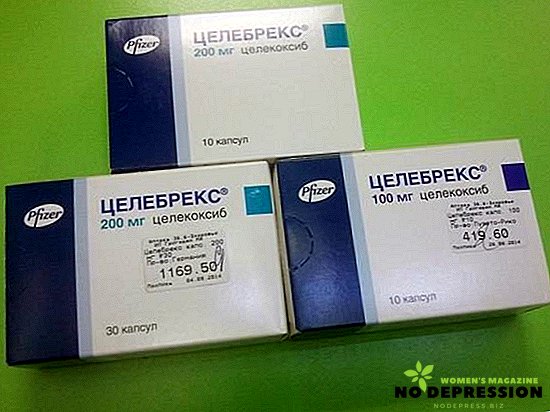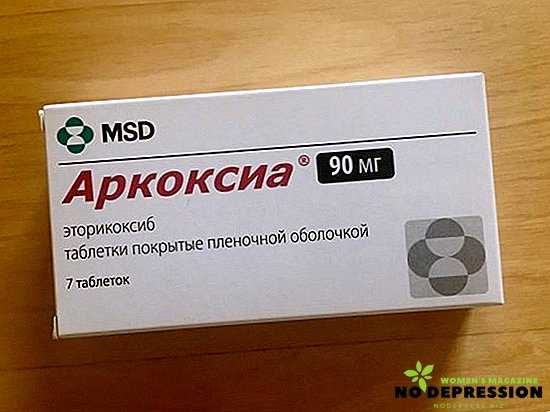Pain in the joints can make life difficult, as it gives a lot of discomfort. The treatment of such diseases is quite complicated, it requires the use of special anti-inflammatory drugs.

The principle of action of nonsteroidal anti-inflammatory drugs
NSAIDs are aimed at inhibiting the production of cyclooxygenase (COX) enzyme. He is responsible for the synthesis of thromboxane, prostaglandins (PG) and prostacyclins, the main role of which is mediative in the inflammatory process.
With a decrease in the level of prostaglandins, the inflammatory process is reduced or by almost 100%. COX-1 is responsible for the normal blood supply of the mucous membrane of the digestive organs and maintaining a stable pH balance of the stomach. But COX-2 is either not present at all, or in small quantities. Its increase signals the presence of an inflammatory process.
Drugs that selectively inhibit the activity of this enzyme act directly on the pathological focus. Due to this, there is no negative effect on the digestive tract organs. But COX-3 does not affect the inflammatory process, responsible only for pain or fever.
Drug classification
By selectivity, NSAIDs are divided into the following:
- Non-selective, which inhibit all types of COX, mainly COX-1.
- Non-selective, influencing COX-1 and COX-2.
- Selective inhibitors of COX-2.
The first group includes the following drugs:
 Aspirin;
Aspirin;- Piroxicam;
- Indomethacin;
- Naproxen;
- Diclofenac;
- Ketoprofen.
The representative of the second category is Lornoxicam.
The third include:
- Nimesulide;
- Rofecoxib;
- Meloxicam;
- Celecoxib;
- Etodolac.
It is worth remembering that Ibuprofen and Aspirin in most cases lead to a decrease in body temperature, but Ketorolac reduces pain. These drugs are practically ineffective for the treatment of the inflammatory process, they can be prescribed only with symptomatic therapy.
Pharmacokinetics of drugs
Systemic drugs when taken quickly absorbed in the body. They are characterized by high bioavailability, which can vary from 70 to 100%. The process can be slowed by increasing the acidity of the stomach.
As a result, active complexes are formed, which freely penetrate the joints, tissues, synovial fluid, concentrating in the inflammatory area. The active substances NSAIDs and their metabolites are excreted by the kidneys.
Are there any contraindications?
It is not recommended to take these drugs in the treatment of diseases of the joints while carrying a child. However, the attending physician, after examining the history and results of tests, may prescribe these agents for treatment if the benefit to the mother is higher than the risk to the fetus.
There are other contraindications:
- individual hypersensitivity to the drug;
- ulcers and erosion of the digestive tract;
- leukopenia;
- thrombopenia;
- renal and (or) liver failure.

The specifics of therapy with NSAIDs
Any funds of this group must be taken under the supervision of a specialist. Moreover, the patient must inform the attending physician of any negative changes so that the treatment regimen can be adjusted.
Therapy should be carried out in small doses over a short period. Remedies in the form of tablets or drops are recommended to be taken after meals, drinking plenty of clean water. This reduces the likelihood of damage to the gastric mucosa. When using drugs in the form of ointments or gels, the risk of side effects is minimal, since the active components do not enter the systemic circulation.
List of nonsteroidal drugs of anti-inflammatory action
Aspirin
Used for many decades. It is prescribed to relieve headaches. Together with other drugs can be used to treat osteoarthritis. But with acute inflammation, Aspirin is replaced by more powerful medicines.

Diclofenac
Sold in the form of tablets, gels, injections. Popular and quite effective means to relieve heat, begins to act in literally 20 minutes.

Ibuprofen
Available in the form of tablets, candles. The first differ in the small price, are easily transferred. They are usually prescribed for bursitis, flu, sprains, SARS, gout, arthritis, fever. Tablets are quite expensive, so you can find a lot of analogues for sale at lower prices.

Nimesulide
With its use, you can normalize the temperature, relieve pain, the body becomes more mobile. On sale can be found in the form of ointment, which is applied to areas with arthritis. In this case, redness may occur on the skin - this is how the effect of the agent is manifested, so you should not worry.

Indomethacin
It is one of the most effective drugs with analgesic effect.
Available in the form of tablets, ointments, candles. Despite the fact that the drug is inexpensive, it helps to cope with arthrosis, arthritis. However, due to the large number of side effects, it is strictly forbidden to take such a remedy without consulting a specialist.

Meloxicam
Available in two forms:
- pills;
- solution for administration to the inside.
It has anesthetic, anti-inflammatory and antipyretic effect. Used for symptomatic treatment, reduces pain and inflammation. It helps in the treatment of osteoarthritis, rheumatoid arthritis, ankylosing spondyloarthritis. Take this tool to be under the supervision of a specialist, and in the absence of side effects, you can drink even a few years. You can buy medicine under various names - Melbek, Artrozan, Mesipol, Mataren, etc.

However, it is worth remembering that some of the above drugs are strictly prohibited for admission in the third trimester of pregnancy.
NSAIDs new generation for the treatment of joints
Medical technology is not in place. Therefore, new medicines are constantly appearing on the market that act more efficiently and suppress inflammation more quickly. It is worth noting that such drugs are more expensive, but at the same time when they are taken the risk of problems with the gastrointestinal tract or cartilage tissue is minimal.
The most popular means include:
- Movalis It is considered one of the most effective means. Ideal for the treatment of osteoarthritis. Even its long-term use does not affect the work of the digestive tract. The remedy also has analogues: Melbek, Mesipol, Mirlox.

- Ksefokam. High-quality drug that relieves pain for a long period - up to 12 hours. Also, the tool is not addictive. However, the high cost does not allow anyone to purchase the drug. It is released on prescription.

- Celecoxib (Celebrex). Is on sale in the form of capsules on 100 or 200 mg. A pronounced fight against arthritis, arthritis does not affect the work of the gastrointestinal tract, the mucosa is not damaged.

- Etoricoxib. A more familiar name is Arcoxia. A day is recommended to use no more than 150 mg of the drug, since in this case, the manufacturer guarantees the absence of a negative effect on the stomach and intestines.

The cost of medicines is different. On the advice of the doctor, the patient may buy a more expensive drug or its equivalent, given the contraindications and side effects. Such drugs will help eliminate severe pain, inflammation, after which they usually prescribe another treatment aimed at eliminating the cause of the disease.
What are the side effects of medication?
Non-steroidal anti-inflammatory drugs have some side effects. For example, they can cause the development of gastrointestinal diseases or exacerbate existing pathologies (gastritis, ulcers, etc.). Often there are dyspeptic disorders, for example, heartburn, nausea, feeling of heaviness.
With regular consumption of these drugs or with an increase in dosage, problems such as coagulation disorder, which is manifested by bleeding, can be observed. With regular use, the number of blood cells can be reduced up to the development of pathologies such as aplastic anemia.
Some of the drugs have nephrotoxic effects, which can cause a decrease in the functional activity of the kidneys or an increase in blood pressure.
Long-term use of funds can cause nephropathy, and some drugs can cause problems in the liver. There is a possibility of developing bronchospasm while taking NSAIDs. Allergic skin reactions are also possible, manifested by itching, urticaria.
The likelihood of developing gastropathy increases in the period of long-term use of drugs in large doses or when taking two or more drugs. To protect the mucosa, may additionally appoint omeprazole, lansoprazole, esomeprazole. Liver damage can occur in the form of severe toxic hepatitis, and this usually occurs when taking Indomethacin, Phenylbutazone, Aspirin.
The greatest danger is observed with the use of Ibuprofen and Naproxen, the long-term administration of which can cause a disruption of the kidneys, cause acute renal failure.
Possible side effects from the blood system Diclofenac, Piroxicam, Butadione are dangerous. Some unwanted CNS symptoms may occur when taking Aspirin or Indomethacin. This is manifested by headache, vomiting.


 Aspirin;
Aspirin;













